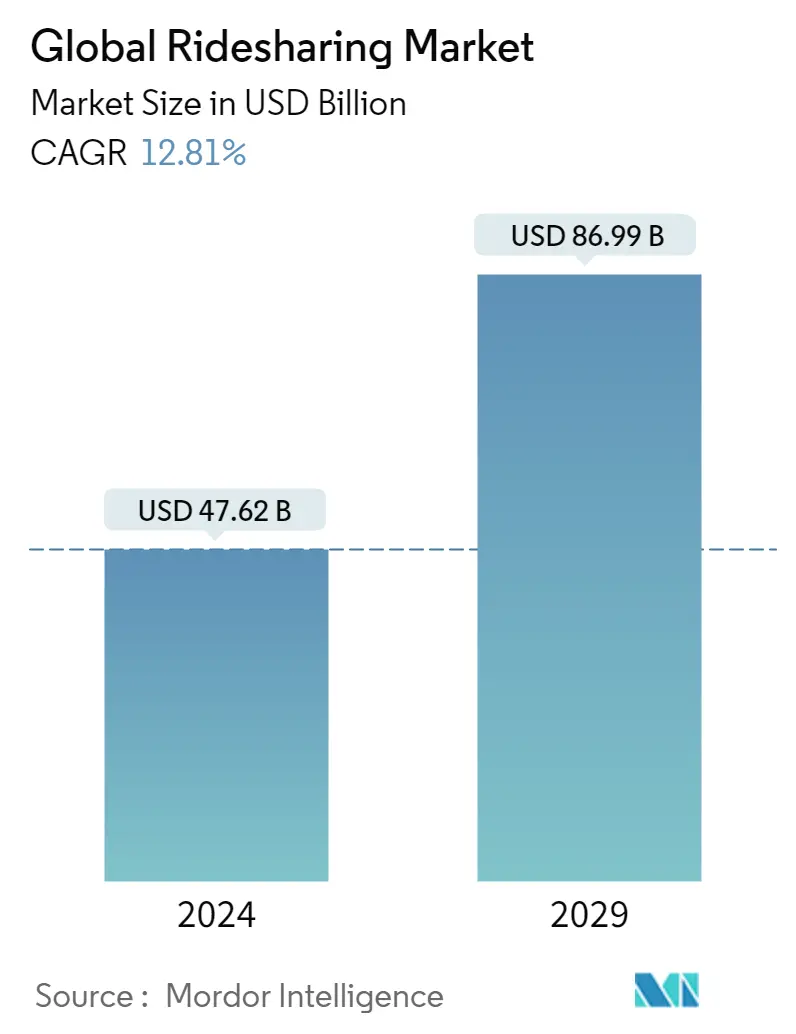Market Size of Global Ridesharing Industry

| Study Period | 2019 - 2029 |
| Market Size (2024) | USD 47.62 Billion |
| Market Size (2029) | USD 86.99 Billion |
| CAGR (2024 - 2029) | 12.81 % |
| Fastest Growing Market | Asia Pacific |
| Largest Market | Europe |
Major Players
*Disclaimer: Major Players sorted in no particular order |
Need a report that reflects how COVID-19 has impacted this market and its growth?
Ridesharing Market Analysis
The Global Ridesharing Market size is estimated at USD 47.62 billion in 2024, and is expected to reach USD 86.99 billion by 2029, growing at a CAGR of 12.81% during the forecast period (2024-2029).
- The Ridesharing market will be driven by increased demand for cost-effective and time-saving transportation. The rising expense of car ownership, the need to minimize traffic for environmental reasons, and government rules encouraging ridesharing services are all significant factors driving the global adoption of ridesharing services.
- Waze, Carma, eRideShare, and CarpoolWorld are some American startups that believe digital networks and smartphones will drive the ridesharing market. Trends such as carpooling are growing on in Europe; French BlaBlaCar already boasts 40 million users globally. Over 500,000 people in the UK use Liftshare. Another factor that will drive the need for ridesharing services is traffic. In Los Angeles, for example, the average commute time is 53.68 minutes. In Europe, Britons face the longest commute of up to 45 minutes. As a result, many governments are pushing ridesharing systems. San Francisco's (BART) Bay Area Rapid Transit system launched a new program to encourage carpooling.
- Due to bad public transportation systems and growing populations and business operations in Asia-Pacific and Latin America, the demand for affordable and effective mobility is developing significantly. Southeast Asia has seen a dramatic ridesharing market increase in the last 2-3 years. Many global vendors have taken advantage of the region's growth in popularity of ridesharing services and are growing their presence in the region.
- These factors fuel the ridesharing app's growth, rapidly becoming the foundation for smart transportation in the region. According to the Dalia survey, 45% of the region's smartphone-owning urban population has used a ridesharing app or site, with Mexico leading the way at 58%.
- The recent COVID-19 pandemic and nationwide lockdown across the world have impacted the ridesharing industry, too. Most of the market vendors have modified or suspended their businesses in an attempt to help stop the spread of coronavirus. In many regions during the recent lockdown, the demand for ridesharing has dropped to the point that these services aren't needed right now. The COVID-19 outbreak has turned customer attention away from ride-hailing services to car rental and owning a car. This is projected to drive some of these customers to ridesharing services, where the customer primarily verifies the driver. As a result, suppliers of longer-term vehicle subscriptions and rentals for premium cars are seeing growth. For example, ZoomCar, an Indian self-drive car rental company, anticipates a huge increase in demand for personal mobility post-lockdown and expects a 3-4 times increase in demand. These trends can also shift users away from ride-hailing services toward ridesharing services.
- Rising carpool operator strikes demanding better and regulated pay rates, criminal charges for nonprofessional drivers, resistance from traditional transportation services, and complex transportation rules may all hamper the growth of the ridesharing market.
